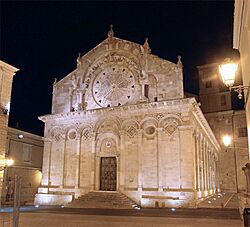Troia, Apulia facts for kids
Quick facts for kids
Troia
Troië (Neapolitan)
|
||
|---|---|---|
| Città di Troia | ||

Cathedral of Troia at night
|
||
|
||
| Country | Italy | |
| Region | Apulia | |
| Province | Foggia (FG) | |
| Frazioni | Borgo Giardinetto | |
| Area | ||
| • Total | 168.25 km2 (64.96 sq mi) | |
| Elevation | 439 m (1,440 ft) | |
| Population
(28 February 2017)
|
||
| • Total | 7,138 | |
| • Density | 42.425/km2 (109.880/sq mi) | |
| Demonym(s) | Troiani | |
| Time zone | UTC+1 (CET) | |
| • Summer (DST) | UTC+2 (CEST) | |
| Postal code |
71029
|
|
| Dialing code | 0881 | |
| Patron saint | Sts. Urbanus, Pontianus, Heleuterius, Anastasius and Secondinus | |
| Saint day | July 17 | |
Troia, also known as Troja in the past, is a town in southern Italy. It's located in the Apulia region, within the province of Foggia. It's called Troië in the local Foggiano language, and its ancient names were Aecae in Greek and Latin.
Contents
History of Troia
Ancient Beginnings
Legend says that Troia, or Aecae as it was once known, was founded by a Greek hero named Diomedes. He was famous for destroying the ancient city of Troy.
Historians like Polybius and Livy wrote about Aecae. They mentioned it during the wars between Hannibal and Quintus Fabius Maximus Verrucosus in Apulia. Like many other cities in Apulia, Aecae joined the Carthaginians after the big battle of Cannae. But in 214 BC, Fabius Maximus took it back after a siege.
Pliny also listed Aecae among the towns in Apulia that were not on the coast. Its location is clear from old travel guides. They show it on the Appian Way, a famous Roman road, between Aequum Tuticum and Herdonia. It was about 18 to 19 miles (29 to 31 kilometers) from Herdonia. This distance matches where modern Troia is today. Many old stories from the Middle Ages say that the current city of Troia was built around the early 11th century on the ruins of ancient Aecae.
Medieval Troia
The Troia we know today was built as a strong, fortified town in Apulia in 1018. It was founded by Basil Boioannes. Its main purpose was to protect the entrance to the Apulian plain from the Normans. For a long time, Troia was a very important town in southern Italy. It was a key strategic spot until the city of Foggia became more powerful.
Because of its importance, Troia was attacked and surrounded many times. Powerful emperors like Henry II and Frederick II tried to capture it. After Frederick II lost power, Troia supported the Angevines. Later, it sided with the Aragonese against the Angevines.
Modern Times
After southern Italy became unified in 1861, Troia rebelled. The new Italian troops had to use cannons to bring the town back under control.
Main Sights to See
- Troia Cathedral: This is a beautiful example of Romanesque architecture from the Apulia region.
- Basilica of St. Basil: An old church built in the 11th century.
- Baroque church of St. Francis: A church built in the fancy Baroque style.
- Church of San Vincenzo: This church dates back to the 10th century.
- Palazzo Principi d'Avalos: A grand palace.
- Jesuits' Palace: Another historic palace from the 16th century.
- Municipal Museum: Here you can see old items found in the area and a collection of art.
- Diocesan Museum: Located in an 18th-century building that used to be a nunnery.
- New Museum of the Cathedral's Treasure: This museum holds important medieval scrolls called the Exultet.
Transportation
As of 2009, Troia was the only town in Italy to offer free public transport for its residents. This means people could ride buses without paying!
See also
 In Spanish: Troia para niños
In Spanish: Troia para niños


